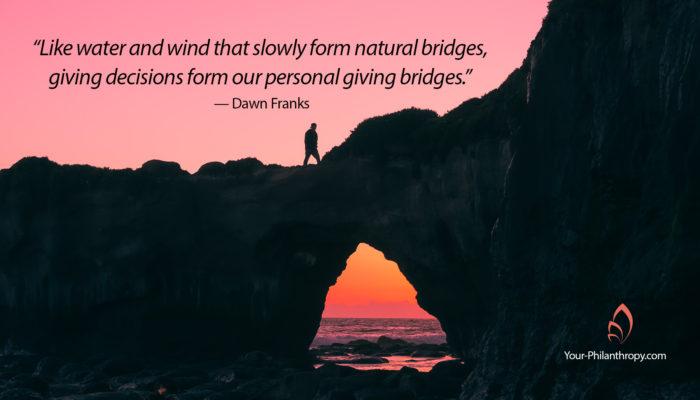I know my childhood memory of the Big Eddy Bridge, now under Lake Palestine in Texas, is not accurate. But the memory is real. Every chance we had my brother, and I would convince my dad to drive over the old and very rickety bridge. It seemed like every board in that old wooden bridge slapped the tires as my dad slowly made his way across. Sometimes he would stop right in the middle and debate whether to continue going across or back up to safely.
I’m not sure how he felt about the drive across. Was he taking a chance or was he confident the bridge would hold on this trip as it had for many years before as cars and trucks of all kinds made their way across it? Of course, I now realize he would never have crossed the bridge if he hadn’t been sure we would get to the other side, but I wasn’t sure and would hold my breath in expectation of something.
I didn’t know what the something should or could be. But I knew there was something.
Our lives are full or bridges, both manmade and symbolic. The places we cannot go or things we cannot learn without bridges are endless. Bridges span obstacles. They come in every size from the short Big Eddy Bridge of my childhood memories to very long bridges.
How Long is a Long Bridge?
I looked for a list of the longest bridges – the longest suspension bridge (6,532 ft. in Kobe Japan), the longest continuous bridge over water (23.87 miles in Lake Pontchartrain, Louisiana), the longest ice bridge (68 miles in Beaufort Sea Road, Alaska), and the longest natural bridge span (400 ft. Fairy Bridge in Guangxi, China).
Every bridge is different in design, and how it is built or naturally formed. Each one accomplishes the same thing – it provides a way over obstacles.
Bridges abound in the world of philanthropy. Some are symbolic; some are tools.
Tool Bridges – from Simple to Sophisticated
Tool bridges range from simple and easy to highly technical. They include year-end check writing and monthly automated giving plans; donor-advised funds, family foundations, and sophisticated estate planning. In each case, the tools provide a bridge for the donor to accomplish goals.
In the case of tool bridges help is sometimes needed to make it stable, to last many generations. Advisors of all types with varied expertise exist to help you build these bridges. Accountants, investment and financial advisors, estate attorneys and philanthropy consultants all have different roles to play in the building of great giving bridges.
Symbolic Bridges – One Decision at a Time
Symbolic bridges are like the 400 foot naturally made Fairy Bridge in China. Accessibly by a three-hour rafting trip in a remote province of China it was only recently discovered and remains relatively obscure.
In philanthropy, these bridges come from the work of learning to give intentionally, with expected impact or outcomes. These are the bridges created one giving decision at a time. Year after year, we learn what works, experience mistakes and disappointments, then give again, trying a different way. Like the Fairy Bridge, our learning journey remains obscure to all but ourselves.
My Favorite Bridges
I especially like the natural giving bridges because each one represents the one person who formed it. Short or long the learning process is personal. It’s like a trip across the Big Eddy Bridge; sometimes you stop in the middle to figure out whether you know enough to keep going or back-up and reassess. You need to ask questions before you make the gift. You need to clarify with the organization your expectations as a donor. The list of possibilities is quite long.
Like water and wind that slowly form natural bridges, giving decisions form our personal giving bridges. We make our way over obstacles, and eventually, we get from here to there.
Have you built a giving bridge? Who helped you build it?
Like it? Use it. Share it. Comment Below.


Very creative metaphor and also substantive. That’s sometimes hard to pull off. You did it.